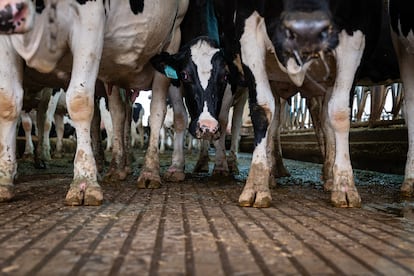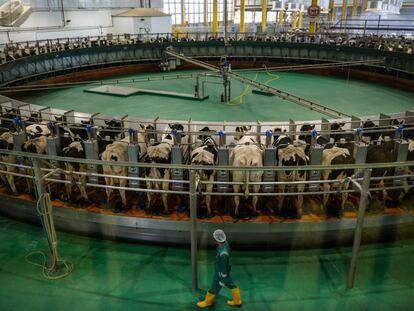A single mutation in avian influenza in cows could enable human-to-human transmission
The authors of a study published in ‘Science’ emphasize the importance of monitoring mutations in both avian and bovine strains of the virus to prevent a potential future pandemic

When early humans domesticated animals and began living alongside them, they could not have foreseen that, in addition to providing meat and skins, these animals would also bring devastating epidemics. Coexistence with animals facilitated the transmission of pathogens between species, and the cities that flourished due to agriculture and livestock were periodically decimated by outbreaks. These epidemics changed the course of history. The Cyprian plague of the third century spurred the rise of Christianity, the Justinian plague weakened the empires of the Near East and contributed to the rapid expansion of Islam, and the Mexican empire fell to a small group of Spaniards who were immune to smallpox.
As the global population has surged in the last century, the frequency of outbreaks has increased. A paper published in Science on Thursday warns that a single mutation in the H5N1 avian flu virus, which currently infects cows, could alter its affinity from animal cells to human cells. Although human-to-human transmission has not yet been reported, the virus has already been detected in at least 282 dairy herds in the U.S. The study suggests that a small change in the hemagglutinin (the “H” in H5N1) could mark the beginning of a more dangerous situation.
The influenza virus infects its host by attaching to cell receptors via hemagglutinin. This protein normally binds to receptors on bird cells, but not typically on human cells. However, viruses have spread globally on migratory birds, jumping between animals, and sometimes mutating to infect new hosts. This occurred when the H5N1 avian influenza, first identified in 1996, reached cows, becoming a bovine disease. In January 2024, the first known case of a human infected with “cow flu” was reported in Texas.
Until now, it was thought that at least three mutations were required for a bird flu virus to infect humans and spread between them. However, in the Texas case, a single mutation in an amino acid of the hemagglutinin allowed the virus to bind to human cell receptors.
Researchers at Scripps Research in San Diego tested the virus in the lab, introducing mutations that could occur naturally. One mutation, Q226L, enhanced the virus’s ability to infect human cells, particularly in the respiratory tract. “This discovery demonstrates how easily the virus can evolve to recognize human receptors,” says Ting-Hui Lin, co-author of the study. However, Lin adds a reassuring note: “Our study does not suggest that this evolution has happened, nor that the current H5N1 virus would be transmissible between humans with this mutation alone.”
Rafael Toledo, a professor of Parasitology at the University of Valencia in Spain, agrees that the mutation marks only the first step in the virus’s potential to infect humans. “This mutation might have other effects on the virus’s biology that, overall, could make it less effective,” he explains. “Or while the virus may access human cells, it might not be able to replicate afterward.”
Toledo continues: “The problem is not so much that the virus reaches humans, but that it multiplies and is transmitted effectively. This involves many parameters that are not included in this study.” Nonetheless, he considers the research crucial for understanding the virus, aiding in epidemiological surveillance, and preparing vaccines or treatments in case of a pandemic.
Pandemic viruses often thrive in environments where multiple species of animals interact, facilitating the exchange of genetic material. Random mutations can create the ideal conditions for a virus to spread among humans. Angela Vázquez, a researcher at the Severo Ochoa Molecular Biology Center of Spain’s CSIC research center, highlights a noteworthy finding from the study: “The udders and respiratory tracts of cows have the typical receptors found in both birds and humans.” This dual receptor presence could allow cows to act as a mixing vessel, where viral strains from different species combine and mutate, potentially creating a more dangerous form of the virus.
The authors of the Science paper acknowledge the limitations of their study and the complexities of real-world infections. However, they emphasize that the growing number of H5N1 cases in humans with direct animal contact necessitates close monitoring of the virus’s evolution. As history has shown, such changes can lead to dramatic consequences.
Sign up for our weekly newsletter to get more English-language news coverage from EL PAÍS USA Edition
Tu suscripción se está usando en otro dispositivo
¿Quieres añadir otro usuario a tu suscripción?
Si continúas leyendo en este dispositivo, no se podrá leer en el otro.
FlechaTu suscripción se está usando en otro dispositivo y solo puedes acceder a EL PAÍS desde un dispositivo a la vez.
Si quieres compartir tu cuenta, cambia tu suscripción a la modalidad Premium, así podrás añadir otro usuario. Cada uno accederá con su propia cuenta de email, lo que os permitirá personalizar vuestra experiencia en EL PAÍS.
¿Tienes una suscripción de empresa? Accede aquí para contratar más cuentas.
En el caso de no saber quién está usando tu cuenta, te recomendamos cambiar tu contraseña aquí.
Si decides continuar compartiendo tu cuenta, este mensaje se mostrará en tu dispositivo y en el de la otra persona que está usando tu cuenta de forma indefinida, afectando a tu experiencia de lectura. Puedes consultar aquí los términos y condiciones de la suscripción digital.
More information
Archived In
Últimas noticias
‘How does it feel to be a failure?’: Elizabeth Berkley’s journey from ‘Showgirls’ ridicule to vindication
The story of the Málaga virus: The code that haunted Google’s cybersecurity center director for 30 years
The impact of Ecuador’s mega-prison: A polluted river, cleared forests and military checkpoints
Corinne Low: ‘I’m more concerned about the female happiness gap than the gender wage gap’
Most viewed
- The low-cost creative revolution: How technology is making art accessible to everyone
- Christian Louboutin: ‘Young people don’t want to be like their parents. And if their parents wear sneakers, they’re going to look for something else’
- All the effects of gentrification in one corner of Mexico’s Colonia Roma
- Liset Menéndez de la Prida, neuroscientist: ‘It’s not normal to constantly seek pleasure; it’s important to be bored, to be calm’
- Christmas loses its festive spirit: ICE fears cast shadow over religious celebrations











































